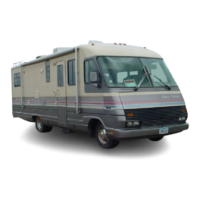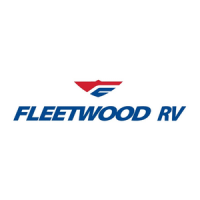Install
tight
fitting
storm
windows
to reduce or
eliminate condensation on
window
glass.
The interior surface
of
the
storm
window
will
be
at least
20
degrees warmer, reducing moisture con-
densation. DO NOT
COVER
THE
EMERGENCY
EXIT
WINDOW.
This
window
must
be
left
accessible at
all
times
for emergency exit.
Reduce
moisture
released Inside
the
motor
home.
Run
the range vent fan when cooking
and
the bath
vent fan (or open
the
bath vent)
when
bathing to
carry
water
vapor
out
of,
the
motor
home. Avoid
making
steam from excessive, boiling or use
of
hot
water. Remove
water
or
snow
from
shoes before
entering
to
avoid soaking the carpet. Avoid drying
overcoats or
other
clothes
inside
the
motor
home.
WARNING:
DO NOT HEAT THE MOTOR HOME IN-
TERIOR WITH
THE RANGE
OR
OVEN. In addition
to
the
hazards
of
toxic
fumes'imd
'oxygen deple-
tion
which
make heating
by
the range or oven very
dangerous, open flames add moisture
to
the interior
air, increasing condensation. Do
not
use
an
air
humidifier
inside the
motor
home. Water
put
into
the air by the humidifier will increase condensation.
Ventilate
closets
and cabinets.
During prolonged use in very cold weather, leave
cabinet
and closet doors partially open
to
warm
and ventilate the interiors
of
storage compartments
built
against exterior walls. The air
flow
wiii
warm
the
exterior
wall surface, reducing
or
eliminating
condensation
and,
preventing
possible
ice
formation.
Install a
dehumidifier
appliance.
During
prolonged, continuous
use,a
dehumidify-
ing
appliance
may
be more comfortable and effec-
tive
in
removing excess moisture
from
the
interior
air. While use
of
a dehumidifier, is
not
a
"cure-a"",
and
ventilation,
storm
windows,
and moisture
reduction
continue
t()
be
important;
operation
of
the
dehumidifier
will
reduce the
amount
of
outside
air
needed
for
ventilati!>n. Heating load
all
the
fur-
nace
will
be reduced, and
the
interior will be less
drafty.
FIRE
SAFETY
The
hazard
and
possibility
of
fire eieists in all areas
of
life, and
the
recreational life-style is no exception.
Your
motor
home,is
a,complex machine, made
up
of
many
materials - some
of
them
flammable. But like
most
hazards,
the
possibility
of
fire can be minimiz-
ed,
if
not
totally
eliminated, by recognizing the danger
and practicing
common
sense safety and maintenance
habits.
Fires are generally caused by unattended food
cook-
ing on
the
stove
or in
the
oven,
faulty
or damaged
wiring and electrical devices, fuel leaks (both
gasoline
and LPG). or carelessness. Under the right cir-
cumstances, almost anything can
be
destroyed
by
fire.
20
The fire extihguisher furnished
with
your
motor
home
is rated for Class 8 (gasoline, grease, flammable li-
quids) and Class C '(electrical) fires since these are
the most common types
of
fires in vehicles. Read the
instructions on
the
fire extinguisher.
Know
how
and
when to use it.
Consider these fire
safety
suggestions:
• Before refueling your
motor
home
or
any generator
fuel tank
that
may
ba installed on
or
in
your
motor
home, be sure
to
turn
off
all
pilot
flames
and
ap-
pliances
in your
motor
home. Explosive fuel clouds
may be present
at
fuel
fiiiing
stations.
•
If
you experience a fire
while
traveling,
MAINTAIN
CONTROL OF THE VEHICLE UNTIL YOU CAN
SAFELY
STOP IT. EVACUATE THE VEHICLE
AS
QUICKLY
AND
SAFELY
AS
POSSIBLE.
•
If
you experience a fire
while
camped, EVACUATE
THE
VEHICLE AS QUICKLY
AND
SAFELY AS
POSSIBLE.
• Consider
the cause and severity
of
the
fire and
the risk involved before
trying
to
put
it
out.
If
the
fire
is
major or is fuel-fed, stand clear
of
the
vehi-
cle
and
wait
for
the, fire
department
or
other
emergency
assistance~
•
If
your motor home
is
damaged by fire. do
not
drive
it
or live in
it
until
you have
thoroughly
examined
it, found the cause
of
the fire, and fixed it.
Smoke
Detector
A smoke detector is furnished
with
your
motor
home
ass
Warning device. See
"APPLIANCES"
sec-
tion.
Instructions
for
Its operation
and
testing
are in-
cluded
Iii'
your
Owner's
Information
Package. Read
thesl.e
instructions and
follo,':I',,~~,~
,~es.tp'~<?p_~dures
out
med.
-'
Smoke
Detector

